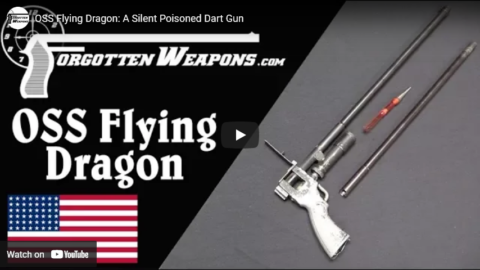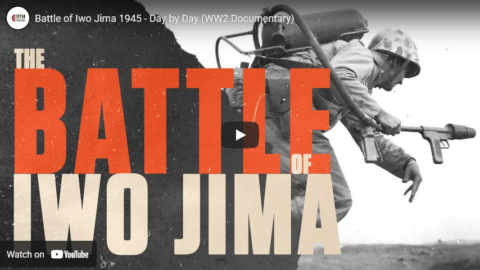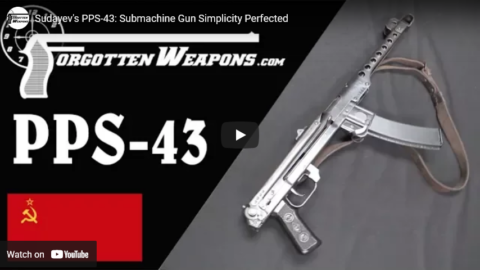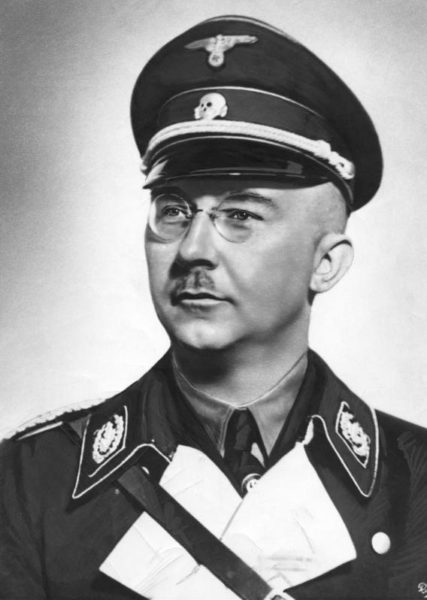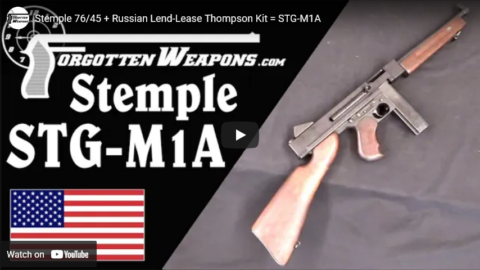World War Two
Published 22 Feb 2022Humanity has spent millennia developing ever more efficient ways to kill. This reaches its apogee in WWI and WWII, the most terrible conflicts in human history. Broken bodies bring with them broken minds. The trauma of war brings with it the mysteries of shell shock, war neurosis and PTSD.
(more…)
February 23, 2022
From Shell Shock to PTSD – Understanding the Trauma of War – WW2 Special
February 21, 2022
D-Day – The Biggest Trick in History – WW2 Special
World War Two
Published 17 Feb 2022It’s 1943, the preparations for D-Day have already begun: deceive the Wehrmacht. Here at TimeGhost, we have begun to prepare our D-Day for 2023, and we want you to join us! Find out how in the pinned comment.
(more…)
OSS Flying Dragon: A Silent Poisoned Dart Gun
Forgotten Weapons
Published 7 Apr 2018The OSS experimented with a lot of … unorthodox weapons during World War Two, and one of their overarching goals was a weapon with a 100 yard lethal range but without flash or noise. To this end they experimented with a number of suppressed firearms as well as weird stuff like various crossbow designs, silenced dart gun pistol conversions, and in this case a CO2 powered dart gun. It was code-named the Flying Dragon, and first mentioned in documents in 1943. In the summer of 1945, 15 were manufactured, and 12 of these remained in OSS stocks at the end of the war.
In July 1945 testing, the Flying Dragon was found the be the second-quietest option (the William Tell crossbow was quieter, at 66 decibels to the Dragon’s 69 decibels). However, the testing board noted that a simple suppressed .22 pistol was pretty much just as good, and quite a lot cheaper (and more reliable, I would expect). The problem with a dart gun like this one is that if it is not reliably lethal, the whole point of it being silenced is lost. Anyone shot by that big dart and not killed by it (which would require a pretty significant muzzle velocity) will immediately start making a heck of a lot of noise. OSS investigated options for poison on the darts to give the weapon the necessary lethality, but was unable to find a suitable solution. This led to discussion of using a small hypodermic syringe as a projectile, an even less practical idea — but this was the freewheeling OSS, where such things were not uncommon to consider.
http://www.patreon.com/ForgottenWeapons
Cool Forgotten Weapons merch! http://shop.bbtv.com/collections/forg…
If you enjoy Forgotten Weapons, check out its sister channel, InRangeTV! http://www.youtube.com/InRangeTVShow
Contact:
Forgotten Weapons
6281 N Oracle #36270
Tucson, AZ 85704
February 20, 2022
Can the Red Army Capture Hitler? – 182 – February 19, 1943
World War Two
Published 19 Feb 2022The Red Army liberates both Rostov and Kharkov this week, but their advancing spearheads are close to an even bigger prize, Adolf Hitler himself. It is the Axis, however, who are both advancing and consolidating in Tunisia, and gearing up for new offensive actions next week.
(more…)
February 19, 2022
When Goebbels Signed Germany’s Suicide Pact – WW2 Special
World War Two
Published 17 Feb 2022Outnumbered, outgunned, and outproduced by the Allies, the noose seems to be tightening slowly but surely around the Third Reich. For Joseph Goebbels, salvation lies in a radical transformation of the economy and society – Total War. But first, he must sell it to the German people.
(more…)
February 18, 2022
Battle of Iwo Jima 1945 – Day by Day
Real Time History
Published 17 Feb 2022Support Real Time History on Patreon: https://patreon.com/realtimehistory
The battle of Iwo Jima in 1945 was one of the most brutal battles of the WW2 Pacific Campaign. The small volcanic island of Iwo Jima had an important strategic position for the US military. But the Japanese Army had learned how to defend in previous hard fought battles on other islands like Guam, Peleliu or Guadalcanal.
Special thanks to Project’44 co-created by Nathan Kehler and Drew Hannen from the Canadian Research and Mapping Association (CRMA). Check out their Iwo Jima map: http://iwojimamap.com/
» THANK YOU TO OUR CO-PRODUCERS
John Ozment, James Darcangelo, Jacob Carter Landt, Thomas Brendan, Kurt Gillies, Scott Deederly, John Belland, Adam Smith, Taylor Allen, Rustem Sharipov, Christoph Wolf, Simen Røste, Marcus Bondura, Ramon Rijkhoek, Theodore Patrick Shannon, Philip Schoffman, Avi Woolf,» OUR PODCAST
https://realtimehistory.net/podcast – interviews with historians and background info for the show.» BIBLIOGRAPHY
Akikusa Tsuruji, 17-sai no Iōtō (Tokyo: Bungei Shunjū, 2006)
Allen, Robert E, The First Battalion of the 28th Marines on Iwo Jima: A Day-by-Day History from Personal Accounts and Official Reports, with Complete Muster Rolls, (Jefferson, NC: McFarland & Company, Inc. Publishers, 1999)
Leckie, Robert, The Battle of Iwo Jima, (New York: Random House, 1967)
NHK Shuzaihan, Iōjima Gyokusaisen: Seikanshatachi ga kataru shinjitsu, (Tokyo: NHK Shuppan, 2007)
Rottman, Gordon L & Wright, Derrick, Hell in the Pacific: The Battle of Iwo Jima, (Oxford: Osprey Publishing, 2008)
Sandberg, Walter, The Battle of Iwo Jima: A Resource Bibliography and Documentary Anthology, (Jefferson, NC: McFarland & Company, Inc. Publishers, 2005)
United States Fleet, Headquarters of the Commander in Chief, Navy Department, “Amphibious Operations, Capture of Iwo Jima: 16 February to 16 March 1945” COMINCH P-0012, (17 July 1945)» OUR STORE
Website: https://realtimehistory.net» OTHER PROJECTS
16 DAYS IN BERLIN: https://realtimehistory.net/16-days-i…
RHINELAND 45: https://realtimehistory.net/rhineland45
THE GREAT WAR: https://youtube.com/thegreatwar»CREDITS
Presented by: Jesse Alexander
Written by: Mark Newton, Jesse Alexander
Director: Toni Steller & Florian Wittig
Director of Photography: Toni Steller
Sound: Above Zero
Editing: Toni Steller
Motion Design: Toni Steller, Philipp Appelt
Mixing, Mastering & Sound Design: http://above-zero.com
Maps: Project ’44 https://www.project44.ca/
Research by: Mark Newton
Fact checking: Mark NewtonChannel Design: Battlefield Design
Contains licensed material by getty images
All rights reserved – Real Time History GmbH 2022
From the comments:
Real Time History
8 hours ago
Support Real Time History on Patreon: https://patreon.com/realtimehistoryWe hope you liked this surprise episode. Special thanks to Project ’44 and the Canadian Research and Mapping Association for their help with this episode. Their map (http://iwojimamap.com/) was the inspiration for this Iwo Jima documentary. We wanted to try out if we could hook their map data to our motion graphics. Iwo Jima was the perfect test case since it was geographically a limited campaign. As you saw, our idea was a success and we will build on what we learned here for our upcoming Napoleon project.
Sudayev’s PPS-43: Submachine Gun Simplicity Perfected
Forgotten Weapons
Published 31 Aug 2017The PPS-43, designed by Alexei Sudayev based on a previous submachine gun design by I.K. Bezruchko-Vysotsky, was the Soviet replacement for the PPSh-41. The Shpagin submachine gun was a very effective combat weapon, but was time-consuming to produce and required specialized manufacturing tools. The Soviet military wanted a weapon that was cheaper and faster to make, and which could be produced at small shops not experienced in firearms production. The Sudayev design fit these criteria extremely well, being made almost entirely of simple bent metal components.
Production of the first prototype Sudayev submachine guns begin in 1942 in the besieged city of Leningrad, where guns were quite literally taken from the factory door to the front lines and put into service. A few minor flaws were discovered and corrected, and by the time the siege was broken the gun was suitable for mass production. It was designated the PPS-43, and while it was theoretically a replacement for the PPSh-41, it never did actually replace the former weapon. It was decided to continue PPSh-41 production in the factories already tooled up for it, while making use of the PPS-43’s simplicity to put it into production as a range of new factories that did not have the technical capacity to make more complex weapons.
Mechanically, the PPS-43 was a simple blowback gun, using basically the same conceptual operating system as the PPSH-41. However, Sudayev resolved the most significant practical problem with the PPSH-41 by abandoning its unreliable drums and developing his own new double-stack, double-feed 35-round box magazine. The PPS-43 magazine is simpler to load, more reliable in use, and much smoother to insert and remove from the weapon than PPSh magazines. The improvement was substantial enough to justify the use of different and incompatible magazines in the two guns. In conjunction with the discarding of the drum magazine, Sudayev also designed his gun to have a lower rate of fire than the PPSh, to better manage ammunition supply. However, the roughly 600 rpm rate of the PPS-43 is actually relatively difficult to control in that light weapon, where the PPSh-41 was substantially smoother shooting despite (or perhaps because of) firing faster.
http://www.patreon.com/ForgottenWeapons
Cool Forgotten Weapons merch! http://shop.bbtv.com/collections/forg…
Русская версия: https://youtu.be/TZxgn4iVMbg
February 17, 2022
Tank Chats #139 | M9 Half Track | The Tank Museum
The Tank Museum
Published 5 Nov 2021Our Patreons have already enjoyed Early Access and AD free viewing of our weekly YouTube video! Consider becoming a Patreon Supporter today: https://www.patreon.com/tankmuseum
Discover how and why this hybrid of a wheeled and tracked vehicle was created during WW2 with Historian David Fletcher.
00:00 – Intro
00:32 – What is the M9 Half Track
05:23 – Features of M9 Half TrackVisit The Tank Museum SHOP & become a Friend: ►tankmuseumshop.org
Twitter: ► https://twitter.com/TankMuseum
Instagram: ► https://www.instagram.com/tankmuseum/
#tankmuseum #tanks
February 16, 2022
Germany’s dual economy during WW2 (and why Himmler would have succeeded Hitler if the Nazis had won WW2)
At Founding Questions, Severian looks at the way the Nazi economy was actually two entities — the “wartime” economy and the effectively separate SS economy under the control of Heinrich Himmler:
Here’s where the Nazis really blew it. “Nazism” should really be called “Hitlerism”, as it was a true cult of personality; there was no ideology without the specific individual man. That’s the tension at the heart of any collectivist ideology — somebody’s got to be The Boss, however temporarily — but Nazi Germany suffered it worse than most. Had the Nazis won the war, the bloodbath at the top would’ve been as spectacular per capita as the war itself. As thoroughgoing Social Darwinists, they only had one possible principle of succession …
Let’s provisionally call that the first consequence of an ideology in power: The personal is the political and vice versa. That seems trite, I realize, but I’m putting it here to emphasize its literalness – in an ideological state, building your own “affinity”, Bastard Feudalism-style, just IS politics. There’s no other possible political activity. And as much as the Nazis seemed to have screwed it up by going all in on the Fuhrerprinzip at the very top, their out-and-proud Organizational Darwinism (for lack of a better term) made them super-efficient at the lower levels.
Let’s bring Khrushchev back in. In many ways, he’s the Soviet Himmler. He was one of Stalin’s right hand men throughout the war, but somehow didn’t get tagged as a major player in the succession crisis until it was too late for all the other contenders for the purple to take effective countermeasures. In the same way, Hitler did announce a successor, sort of. In fact he did it twice: Before the war, it was Rudolf Hess; during the war, Hermann Goering. Neither of those guys had anything approaching the power Himmler had, but like Khrushchev, his personality was such that the other bigshots couldn’t help overlooking him. Just as the rest of the Politburo couldn’t wrap their heads around the idea of this uncouth quasi-Ukrainian peasant being a major threat, so the rest of the Nazi leaders couldn’t help seeing Himmler as this fussy little file clerk.
It’s a hell of a trick, and I’ll admit, I’m buffaloed. Even if Himmler (Khrushchev) was one hell of an actor, and the egos on the other top Nazis (Soviets) were gravity-defying, they still should’ve been able to see that this fussy little file clerk had some seriously hard boys working for him. Reinhard Heydrich was as ruthless a fuck as was ever born, and Himmler kept him in check. Ditto barbarians like Odilo Globocnik and Erich von dem Bach-Zelewski — they don’t come any nastier than those two, yet Himmler managed them easily. What other conclusion can you possibly draw about Himmler, other than that he was nastier than all of them put together? And yet, apparently, nobody did …
The only explanation for this that I can think of is the Nazis’ ideologization of governmental structures. As opposed to the Soviet experience, where the Party and the Bureaucracy were supposed to be, and often actually were, distinct. After some disastrous experiments with demoting technical experts to field hands, and vice versa, the Russian Communists learned that ideological correctness and “soviet power” does not, in fact, obviate the need for stuff like math. (See also: Mao’s backyard blast furnaces). So the Soviets made sure to separate what they called the “technical intelligentsia” from the Party. The head honcho at Gosplan, Gossnab, etc. would be a Party hack from way back, of course, but the actual brainworkers wouldn’t be. I don’t know just how many of them had Party membership cards, or if any of them did, but nobody I know of rose through the Party’s ranks via Gosplan.
Once a Gosplanner, always a Gosplanner. The technical intelligentsia got all kinds of perks in the Soviet system, but one thing they did not do was get perks inside the Party. You can be a technical expert, or you can be an up-and-coming Party man, but you can’t be both.
The Nazis did the exact opposite of that. The way the Third Reich actually functioned is still opaque in a lot of ways (especially to non-specialists), and of course the pressures of wartime forced a lot of ad hoc measures, but it seems like the SS was supposed to be a sort of All-Purpose Expert Corps. Not only did they have their own army and intelligence service, but they had their own economy — the brief history of the Third Reich makes a lot more sense when you realize that half or more of the official Reich economy was hamstrung by the informal but very real SS economy, operating largely (but far from exclusively) through the labor camps.
Indeed, the SS had their own administration. As incredible as it seems, the Nazis had no grand plan for what to do once they’d conquered Europe. Himmler did, at least as far as the East was concerned, and he tried his damnedest to put it into action in Poland (which is why the General Government was so legendarily brutal). Hitler apparently thought in terms of Germany’s lost late 19th century colonies, when he bothered to think about it at all … which wasn’t often. In his typical Fuhrer-riffic style, he just ignored the problem, trusting to Organizational Darwinism to sort it out …
… which is where the All-Purpose Experts of the SS stepped in. The General Government, for instance, was headed by a civilian lawyer, Hans Frank, but the day to day governance largely fell to the SS, because that’s who stepped up. Poland was an occupied zone, with vital war industries, but it was far behind the front for most of the war; the army couldn’t waste vital manpower garrisoning it. Thus the SSPF (the SS and Police Leader) stepped in, drawing manpower as needed from a wide variety of sources — the camp guards, the Wehrmacht (when garrison troops were available, and when they could wrangle them from the various army commanders), the civilian police, the “General SS”, and so on.
The details aren’t nearly as important as the big picture, which is: Unlike the technical intelligentsia in the Soviet Union, members of the SS could climb to the highest ranks of the Party. Indeed they were expected to: the SS was rapidly becoming a Party-within-the-Party at the outbreak of the war, not least because Himmler awarded a “ceremonial” SS rank to anyone who mattered politically in the various departments. The savvier guys refused the “honor,” of course, because they didn’t want to be subordinate to Himmler, even ceremonially, but many didn’t. Which meant that had the Nazis won the war, not only would Himmler have been the next Fuhrer, but the SS would’ve closed ranks, essentially taking over The Party — they’d be the Inner Party, as opposed to the “mere Nazis” of the Outer Party.
February 15, 2022
Total War on Valentine’s Day – WW2 – Reading Comments
World War Two
Published 14 Feb 2022Another installment of Across the Airwaves, where we highlight some of the best viewer comments under our videos. It’s Valentine’s Day and we’re feeling pretty romantic, so Indy and Spartacus will be reading comments that are all about love, humanity, and relationships.
(more…)
Krieghoff: Lugers for the Luftwaffe
Forgotten Weapons
Published 20 Oct 2021http://www.patreon.com/ForgottenWeapons
https://www.floatplane.com/channel/Fo…
Cool Forgotten Weapons merch! http://shop.forgottenweapons.com
One of the scarce, small-production manufacturers of the Luger is Krieghoff — Heinrich Krieghoff to be exact. Kreighoff Waffenfabrik was a smallish arms company that wanted to get into major contracts with the rearming German military in the 1930s. They began by bidding on a contract for 10,000 Luger pistols for the Luftwaffe, and won. Krieghoff had previously worked as a subcontractor for the Simson company rebuilding Lugers under the Weimar government. Kreighoff got control of the Simson Luger tooling, and used it to manufacture a new set themselves.
Krieghoff built a total of 13,825 Luger pistols. The first 10,000 were delivered to the Luftwaffe between 1935 and 1937. A further 2,000 were delivered in small batches between 1940 and 1944, with a final 200 in 1945. In addition to these, 1,625 were sold commercially, including a few highly embellished examples. They are renowned for their excellent quality, and have always attracted particular collector interest.
Contact:
Forgotten Weapons
6281 N. Oracle 36270
Tucson, AZ 85740
February 13, 2022
Victory at Guadalcanal – WW2 – 181 – February 12, 1943
World War Two
Published 12 Feb 2022Operation KE, the Japanese evacuation of Guadalcanal, concludes this week and the campaign has been a big loss for the Japanese. The Axis forces are also withdrawing — and the Red Army advancing — in the Donbas and the Caucasus, closing in on both Kharkov and Rostov. And a front that’s been quiet for a while, the Burma front, begins heating up again with an Allied advance out of India.
(more…)
February 12, 2022
Stemple 76/45 + Russian Lend-Lease Thompson Kit = STG-M1A
Forgotten Weapons
Published 8 Oct 2021http://www.patreon.com/ForgottenWeapons
https://www.floatplane.com/channel/Fo…
Cool Forgotten Weapons merch! http://shop.forgottenweapons.com
The modularity and clever design of the Stemple Takedown Gun is perhaps best illustrated by the STG-M1A and STG-1928 (these are the same gun with either a horizontal or vertical front grip). In the early 2000s a bunch of Thompson parts kits came into the US, WW2 vintage lend-lease guns sent to Russia. They were M1 and M1A1 models, and had intact barrels but torch-cut receivers. BRP, who makes the Stemple, realized that the sear-to-magwell dimensions on the Thompson were almost identical to the Suomi and Stemple — and that he could make a version of the STG that was a nearly perfect clone of the M1 Thompson.
The registered Stemple receiver slides into a square Thompson lookalike housing, and original Thompson grips, stocks, and hand guards are used. It is chambered for .45ACP, using original Thompson stick magazines (naturally). The result is a submachine gun that almost perfectly duplicates the handling of a true Thompson, without the historical value that makes the Thompson so expensive and keeps many owners from wanting to actually take their Thompsons out to the range.
Note that the gun in this video is an early example, and models made today are able to take both stick and drum magazines. Also, due to the design of the disconnector in the original Thompson FCG, the semiauto setting is not functional in the Stemple version — it’s only full automatic.
Contact:
Forgotten Weapons
6281 N. Oracle 36270
Tucson, AZ 85740
February 11, 2022
Eat the Nazis, There’s Nothing Else – WAH 052 – February 1943, Pt. 1
World War Two
Published 10 Feb 2022As the United Nations alliance, and the Resistance in occupied Europe increase their pressure on Nazi Germany, they continue to escalate their war on humanity. Meanwhile, in more and more parts of the world there is little to eat.
(more…)
February 10, 2022
MI6’s Secret War – WW2 – Spies & Ties 13
World War Two
Published 9 Feb 2022Britain’s MI6 is caught off guard when war breaks out. As the Germans advance across Western Europe MI6’s networks collapse, and Britain becomes almost blind. MI6 have their secret weapons at Bletchley Park but they now face a painful struggle to rebuild their eyes in Europe.
(more…)

